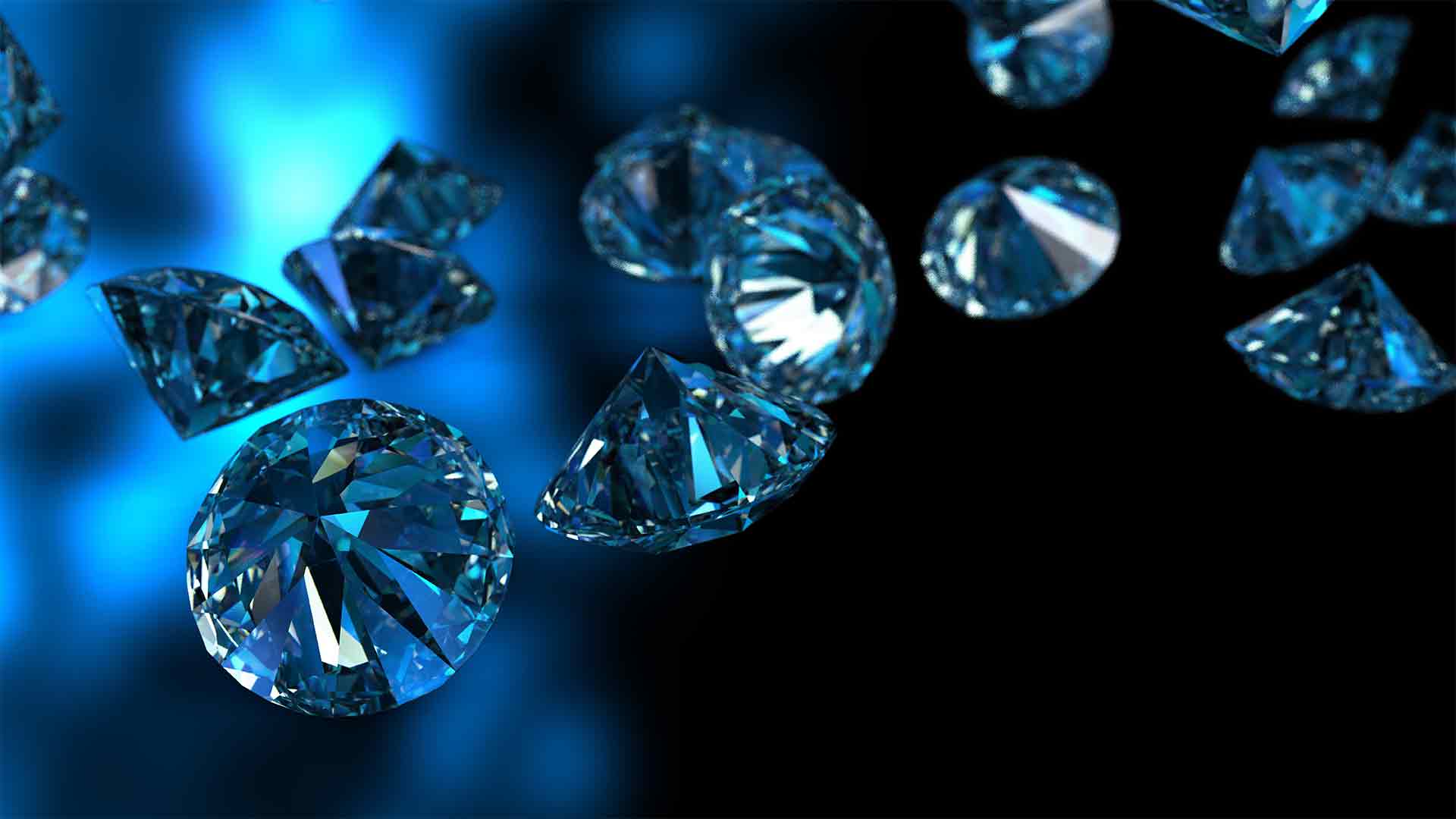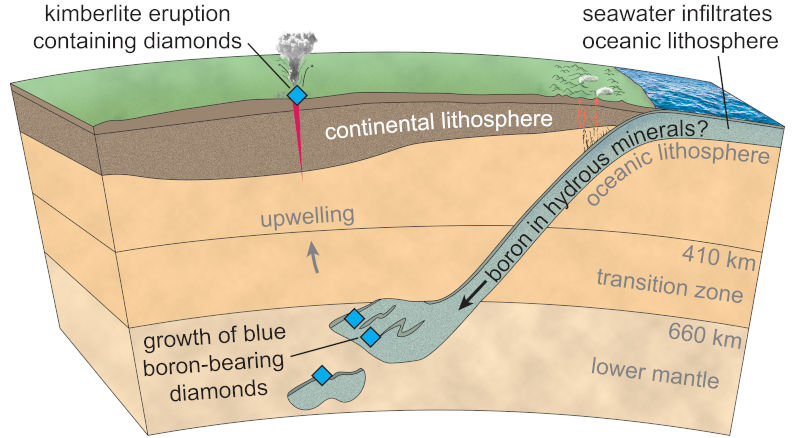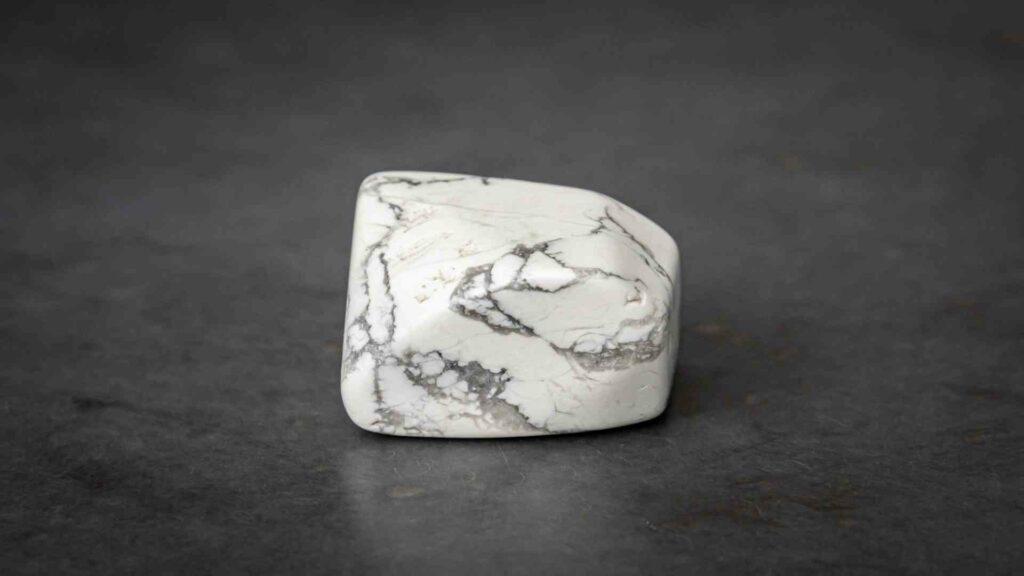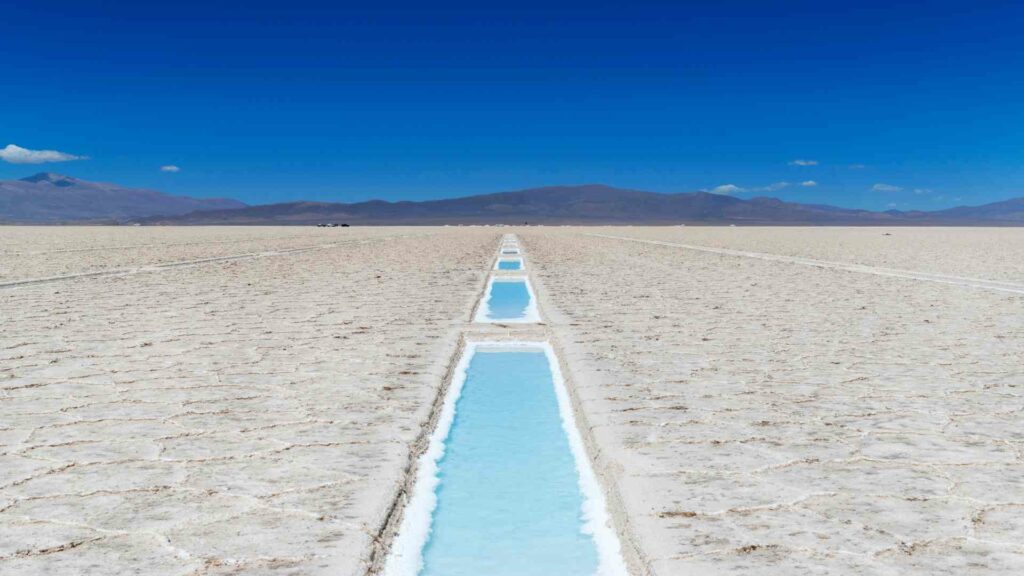Boron Blue Diamonds from the Deep
Boron blue diamonds: Diamonds are valued for their luster and sparkle, making them precious commodities. Creating the beautiful diamond jewels people adore as betrothal or pure indulgence symbols is a complex and lengthy process. Some diamonds are rarer than others. Believe it or not, Boron is the trace element that gives some rare diamonds a blue color – the story of the Hope diamond is one such beneficiary of Boron’s color.

Boron Blue Diamonds
What are Diamonds
The hardest natural substance known to man is diamond. Diamonds are formed deep inside the Earth during volcanic eruptions. The lava cools down, and the pressure within the rock builds up. Over time, the pressure becomes too great, and cracks appear. It is because of these cracks that gases can escape into the environment.
When gases escape into the environment, bubbles are formed. These bubbles grow in size for thousands of years until they reach the ocean’s surface. The bubbles burst at the water’s surface and form a thin film of liquid. In enough heat, the liquid can turn into a diamond.
Value of Diamonds in the Market
Diamonds do not have a spot market like other mined commodities such as copper, gold, oil, or coal. Value is determined according to the “4C” system: color, clarity, cut, and carat (5 carats = 1 gram). Uncut diamonds typically cost between $US10 and $US3000 per carat. Large (and sometimes historic) gem-quality diamonds can sell substantially more than this.
Traded in India in the early 1600s, the 45.5-carat Hope Diamond is valued at more than US$200 million. The Pink Star (59.6 carats, $US71 million) and the Oppenheimer Blue (14.6 carats, $US57.5 million) were recent high-priced diamond sales. “Lesedi La Rona,” an uncut Botswanan 1,109-carat diamond, is the largest diamond recently sold. Approximately US$53 million was paid for it.
Diamonds are sought after by the world, and blue diamonds have a history of scandal, theft, curses, and diplomatic wranglings worldwide. The curse of the Hope Diamond is charted here, and earlier in 2020, the end to a saga going back to 1989 came about when Saudi Arabia and Thailand ended a dispute over stolen blue diamonds, which led to lost trade and business between the two kingdoms for over 30 years.
Where Most Diamonds Come From
Diamonds
Rare Diamonds are not always colorless, often having a slight yellowish hue. Despite their rarity, some have prominent yellow, brown, pink, or green shades. Many of the s are formed at depths of 90 to 125 miles (150 to 200 kilometers) underground – shallower than the blue diamonds.
Diamonds with Blue Flashes
Some of the world’s most famous jewels are blue diamonds, which make up only about 0.02 percent of mined diamonds. The researchers discovered that blue diamonds crystallize with water-bearing minerals that were once part of the seabed but were pushed into the Earth’s interior by the inexorable movement of huge tectonics.
Scientists knew the origin of this diamond’s blue hue–the element boron. According to this research, Boron once existed in ocean water and was incorporated into the seafloor rock, which moved deep underground over many millions of years.
Blue diamonds have never before been explained in a fact-based manner. Until now, we had no idea where these minerals form, what kind of host rocks they form in, or how they might obtain Boron,” said Gemological Institute of America research scientist Evan Smith. The study was published in the journal Nature.
Boron Responsible for the Blue
Blue diamonds exhibit the same inherent characteristics as diamonds but have an additional color element. The crystal’s lattice structure is contaminated with trace amounts of Boron, which renders them blue. As a subcategory of fancy color diamonds, blue diamonds fall under intensely colored diamonds.
Properties of Blue Diamonds
Blue diamonds are graded based on the same four criteria that govern all gemstones-the four Cs of Connoisseurship: color, clarity, cut, and carat weight. In grading and determining the value of a blue diamond, color is considered the most significant factor. Nonetheless, the most valuable blue diamonds also possess the highest clarity grades. No blue diamond is known to have been graded completely flawless (F). However, several blue diamonds have been graded internally flawless (IF).
The Hope Diamond, a 45.52-carat fancy dark grayish-blue diamond believed to have been discovered in India, was first documented in 1666 by French gem merchant Jean-Baptiste Tavernier and named the Tavernier Blue. This blue diamond was last owned by Harry Winston, who donated it to the Smithsonian National Museum of Natural History in Washington, D.C. Colourless (“White”) diamonds have remained the most popular type of diamond throughout history, but the existence of this blue diamond so long ago affirms the growing demand for fancy colored diamonds.
Colour
The three components of color in gemology are hue, saturation, and tone. Diamonds possess a spectrum of blue hues, ranging from green-blue to gray-blue, with blue being the primary hue. Blue diamonds commonly exhibit secondary hues of green and gray. When a blue diamond is free from any secondary color but only possesses a purely blue color, it is considered the most valuable and beautiful diamond. Even so, a colorless pure blue diamond may be regarded as less valuable than a green-blue or gray-blue diamond whose color is more vivid.
For this reason, the color characteristic of blue diamonds is very complex. In most cases, blue diamonds are Type IIb, meaning their nitrogen content is very low or non-existent. In type Ia blue stones, hydrogen is present, contributing to their color.
Boron in the Deep Earth’s Mantle
The element boron can be found in high concentrations in the upper continental crust (less than 20 km below sea level) and ocean water. The element is rarely present in deeper mantle rocks but has also been found in the deeper layers where diamonds were formed.

Boron Blue diamonds
Source: NEWS.UCT
Boron: The Journey to Blue Diamond
The deep subduction process occurs when the boundary of an oceanic tectonic plate (about 100km thick) breaks, and the plate falls onto the deep Earth’s mantle. As a result, Boron and other materials have been transported from the shallow layers of the Earth into depths of over 700 km. Kimberlite eruptions then brought the diamonds up toward the surface.
Besides the Hope Diamond‘s fabled curse, blue diamonds have yet to become a significant part of world culture. However, the blue diamond has become the most sought-after gem at auction as of 2015. In a surprising move, Hong Kong billionaire Joseph Lau purchased a 9.75-carat “Zoe” diamond for his daughter Zoe, whom he named it after.
In the T.V. show Steven Universe, the character Blue Diamond is a member of the Great Diamond Authority.
| Blue Diamond | Origin | Notability |
|---|---|---|
| Hope Diamond | Kollur Mine, Golkonda,India | Almost four centuries of ownership records make it one of the most famous jewels in the world. |
| Baby Hope Diamond | Kalimantan, Indonesia | As the diamond phosphoresces red, this was once considered a lost Hope diamond. Kalimantan in Indonesia is one of the oldest known diamond sources with a 7.26-carat deep blue diamond |
| Wittlelsbach-Graff Diamond | Kollur Mine,Golconda,India | From Austrian royalty to Laurence Graff and repolished in 2008 |
| The Tereschenko Diamond | Probably, Kollur Mine, Golconda, India | Robert Mouawad acquired it at auction in 1984 from the prominent Tereschenko family |
| Heart of Eternity | South Africa | Featured in De Beers Millennium Jewels in 2000, exhibited in Smithsonian's "Splendor of Diamonds" exhibition in Washington D.C. in 2005 |
| Sultan of Morocco Diamond | Kollur Mine, Golconda, India | Ownership passed to the Moroccan Sultans from the Yousupov family in Russia |
| The Transvaal Blue Diamond | Premier Mine ( now called the Cullinan Mine), Transvaal, South Africa | Once owned by the Baumgold Bros, current owner is unknown |
| The Zoe Diamond | Probably South Africa | The blue diamond, owned by Rachel "Bunny" Mellon, was sold at auction for $32.5 million in 2014, the highest price ever paid for a diamond and the highest price per carat ever paid. |
| The Blue Moon of Josphine Diamond | South Africa | Sold at auction to Hong Kong billionaire Joseph Lau Luen-hung in November 2015 for his 7-year-old daughter Josephine, one year after he bought the Zoe diamond for his 12-year-old daughter Zoe. $48.5 million was the highest price ever paid for the Blue Moon of Josphine diamond at auction, the highest price paid for a blue diamond, and the second highest price paid per carat ever paid for a diamond. |
| The Oppenheimer Blue Diamond | Premier Mine, South Africa | The blue diamond, once owned by the Oppenheimer family, sold at auction at $58 million in 2016, making it the highest price paid ever for a diamond. |
| The Okavango Blue | Opra Mine, Botswana | Botswana's largest blue diamond caught media attention because of its original size, 41.11 carats, which is comparable to that of the famous Hope Diamond, whose clarity and purity it surpasses. Cut and polished to 20.46 carats |
Clarity
When grading diamonds, the loupe standard is used. A diamond’s inclusions are judged under a 10x magnification and not from how they appear to the naked eye. Unlike in colorless diamonds, the clarity in blue diamonds has little effect on the diamond’s value. A very vividly colored diamond can have exceptionally high clarity in rare cases. Clarity can add tremendous value in these cases.
Treatments
The only blue diamonds that are valuable and rare are natural ones. Since the 1950s, many methods have been developed to alter the appearance of diamonds, including adding color to a colorless stone. A natural blue diamond is a natural blue diamond mined with its blue color already present. Enhanced blue diamonds are not bought with the intention of investment or eventual resale. They have no value or resale value comparable to natural blue diamonds. HPHT has also been used to create synthetic blue diamonds.
Case Study: The Hope Diamond
The Hope Diamond is one of the world’s most valuable treasures. According to its name, “Hope” refers to the belief that whoever owns it will be blessed with good fortune. The Smithsonian Institution has displayed it since 1837. It was discovered in India in 1795. It is said that Emperor Shah Jahan gave the diamond to Mumtaz Mahal, his favorite wife. Before giving birth to her son Aurangzeb (the future emperor), she named him Aurangzeb “The Golden Crown.” Later the jewel was called the “Mumtaz Mahal Diamond” after this name.
The gem had been displayed for over 200 years in the British Museum before it was stolen in 1911. A safe deposit box in Antwerp held the item discovered in 1913. Two pieces of the gem were sold separately. Harry Winston received one piece, and Harry Oppenheimer received the other. They were both New York-based diamond dealers. Upon selling the stone, they split the proceeds 50/50. New York’s Metropolitan Museum of Art received the larger half as gifts from the Oppenheimer family. The Oppenheimer Blue, a blue diamond on display at the Smithsonian National Museum of Natural History, sold for $57.5 million at auction in 2016, besides the Hope Diamond on display at the museum.
The Golconda diamond mine was established by Mirza Raja Jaisingh I in 1559. The mine was located northeast of modern-day Mumbai, near Hyderabad. Due to the abundance of gold deposits, Golconda was known. Gems and minerals were also abundant. The mines’ rich gemstones were rubies, sapphires, emeralds, and topazes. In 1687, the River Musi flooded the mines, forcing their closure.
The Hope Diamond measures 45.52 carats. This diamond weighs approximately 9.104 g.
Pear-shaped, brilliant Hope Diamonds are perfectly symmetrical, brilliant diamonds. The gemstone has a heart-shaped shape. It is blue due to trace amounts of Boron.
It is mined from Guntur, India’s Kollur Mine, which first emerged in the 17th century. It belongs to the Golconda diamonds collection.
Today, the location of the original mine is unknown. However, there are several theories regarding the source of the original diamond. According to some historians, the diamond was originally mined in the Deccan Plateau region of southern India. Others believe that the gem originated in Burma. Still, others claim that the Mughals took the diamond from Golconda.
Jean-Baptiste Tavernier purchased the diamond as the Tavernier Blue in 1666, according to the first record of the diamond. In 1668, Tavernier sold the stone to King Louis XIV of France. The stone was renamed the French Blue (Le bleu de France). An 1839 gem catalog from the Hope banking family shows the most significant section of the diamond under the Hope name after it was stolen in 1791. The precious commodity is estimated to be worth between $200 and 350 million dollars in today’s market.
Diamond Production Sources
Diamonds have been valued as valuable gems for a long time. Still, until the early 1700s, nearly all diamonds traded came from river gravels in India (known as alluvial deposits).
In the early eighteenth century, diamonds were later discovered in Brazil and mined in South Africa from 1866. A violently erupted volcanic rock known as kimberlite, the major source of diamonds, was found for the first time in the USA.
Diamond exploration and mining changed fundamentally due to this recognition, which led to a huge increase in production and high demand for diamonds in the modern jewelry industry.
In the past, the supply of diamonds to the market has been heavily dominated by a few significant producers – Lucara Diamond Corporation (Karowe Mine, Botswana) and De Beers (South Africa-Botswana).





